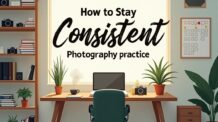Food photography is more than making meals look pretty — it’s about making them look delicious. Whether you’re creating content for social media, shooting for a blog, or building a portfolio, learning how to photograph food well can elevate your work and tell a flavorful story.
The good news is that you don’t need a professional studio or expensive gear to take mouthwatering food photos. With smart use of light, styling, and composition, you can achieve pro-level results right from your home.
Use Natural Light
Lighting is the most important element in food photography. Natural light is your best friend, especially when shooting at home.
Tips for using natural light:
- Set up near a large window for soft, diffused light
- Avoid direct sunlight which creates harsh shadows and highlights
- Use a white curtain, sheer fabric, or parchment paper to diffuse strong light
- Position your setup so light comes from the side or back to create depth and texture
Turn off all artificial overhead lights to keep your white balance clean and consistent.
Keep Your Setup Simple
You don’t need a big space to shoot beautiful food photos. A small table or even a chair by the window will do.
Basic home setup:
- A flat surface like a wooden table, tray, or piece of plywood
- A simple background such as white foam board, black cardboard, or a textured surface
- A reflector (white foam board or aluminum foil) to bounce light
- A camera or smartphone with manual settings if possible
Use what you already have — food photography is more about creativity than gear.
Choose the Right Props
Props help tell the story behind the dish. Choose them carefully and make sure they don’t distract from the food.
Prop tips:
- Use neutral-colored plates, bowls, and cutlery
- Stick to matte finishes (shiny items reflect light harshly)
- Add natural textures like linen napkins, wooden boards, or ceramic cups
- Include ingredients or kitchen tools related to the dish for context
- Keep props small and in proportion to the food
Always ask yourself: does this add to the story or clutter the frame?
Style Your Food with Intention
Food styling is about arranging the elements to look natural and appetizing. Less is often more.
Styling basics:
- Avoid overloading the plate — leave breathing room
- Use fresh garnishes for color and texture (herbs, seeds, spices)
- Cut or shape ingredients to show off their best features
- Add a drizzle or dusting (olive oil, powdered sugar, sauce) just before shooting
- Use tweezers, paper towels, and small brushes for precision
If a dish looks too messy or brown, try adding fresh greens, a squeeze of lemon, or a colorful side.
Composition Tips That Work
Just like other types of photography, food photography benefits from strong composition.
Try these approaches:
- Overhead (flat lay): great for bowls, spreads, and symmetrical scenes
- 45-degree angle: works well for plated meals and drinks
- Straight on: best for stacked items like burgers, cakes, or sandwiches
Use the rule of thirds to guide your framing and keep your subject off-center for a more dynamic look.
Add layers: use a background, plate, napkin, garnish, and utensils to create depth and interest.
Work Quickly with Perishable Foods
Some dishes start to wilt, melt, or dry out fast — especially hot meals, ice cream, or beverages. Be ready to shoot as soon as the dish is prepared.
Tips:
- Set up your shot before bringing in the food
- Use stand-ins (like mashed potatoes for ice cream) when needed
- Work in stages if shooting multiple angles
- Have a cloth on hand to wipe spills or splashes
Preparation is key to keeping the food looking fresh and photogenic.
Use Editing to Enhance, Not Overpower
Editing can polish your food photos, but it should always support a natural, appetizing look.
Edit with care:
- Adjust exposure and contrast to bring out details
- Fine-tune white balance to maintain true colors
- Boost vibrance, not saturation
- Sharpen slightly to enhance textures
- Crop or straighten for stronger framing
Avoid overediting — food should look real and edible, not artificial or overly processed.
Practice with Everyday Meals
You don’t need a gourmet dish to practice food photography. Use your morning coffee, a sandwich, or a bowl of fruit to try different lighting and styling techniques.
Ideas for practice:
- Shoot one dish in different lighting conditions
- Style the same plate with different props and angles
- Challenge yourself to tell a story with ingredients or preparation steps
Every meal is a new opportunity to improve your eye and develop your style.
Final Thoughts
Great food photography starts with observation, creativity, and practice — not a professional kitchen or high-end camera. By mastering natural light, styling with intention, and composing your shots thoughtfully, you can create images that not only look good but make people hungry.
Whether you’re photographing a recipe, building a portfolio, or just sharing your lunch, remember: the best food photos don’t just show what a meal looks like — they make you feel like you can taste it.




Deixe um comentário